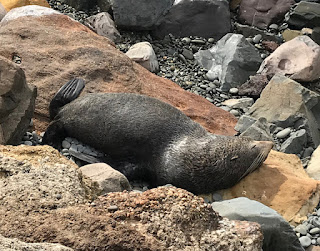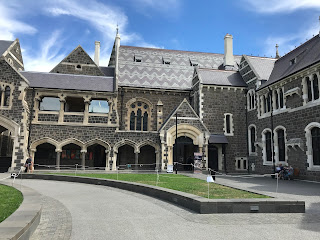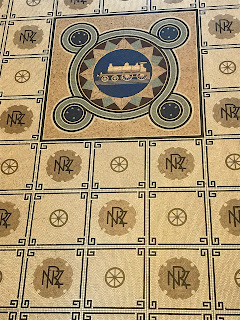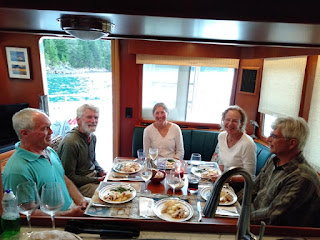Stewart Island is the third largest island in New Zealand, located south of the South Island, and separated from it by the twenty-mile wide Foveaux Strait. It is a different world. Few people live here, almost all of them in the only town, Oban. The vast majority of the almost seven hundred square miles is either national park land, or otherwise undeveloped wilderness. There is considerable history here; some of the earliest settlements in New Zealand were on Stewart. Whaling was a major industry. And if steam hadn’t replaced sail over a century ago, Stewart Island would be a major shipping center today. Now, the settlements and industry of yesteryear are merely relics. The locals are mostly fishermen and tour operators. Wildlife, dense forests, dramatic coastlines, etc. are what people come here to see. That is what drew us to cold high latitudes this summer, a thousand miles to the south of our usual summer cruising grounds.

Otago Harbour and the city of Dunedin was our last stop before the jump to Stewart. Having enjoyed our many stops along the way this summer perhaps too much, the season was now well advanced. Finding suitable weather for even short passages down here sometimes requires patience, so as we waited in Dunedin (enjoying every moment!), we wondered if we would actually get to Stewart, and if we did, how much time we would have there. Luck was with us, though, with two days of calm. Once again resorting to the iron wind, we motored on flat water under mostly clear skies to and across the often ill-mannered Foveaux Strait to Oban.
I should mention at this point that, despite the surprising amount of motoring we’ve done on this cruise, we have not actually sought out such conditions. We would much rather sail than motor, but the forecasts were repeatedly either calm winds or, more often, unfavorable ones. It was either motor or wait. But the summer lasts only so long, and we would much rather spend the coming winter at home in Whangarei, so we motored.
Pulling in to Paterson Inlet, we anchored in Golden Bay, just a short walk over a low ridge from Oban. We only spent one night there, but we did so much, it seemed longer. We went ashore a couple of times, checked out the town, the visitor center, the grocery store, refueling possibility, and took a couple of nice walks on well constructed tracks. Next day, we moved a couple of miles to what is known as “The Whalers’ Base.” This was once a place of significant industry. A small community lived there, repairing whaleboats and otherwise servicing the whaling fleet. Now, there are just some old foundations in the bush, and a number of large propellers rusting on the beach. An added bonus was endless mussels on the rocks.
There were two other boats anchored there, one of them was a sailboat we recognized from back in Whangarei, called Kiwi Logic. We had seen them on the next pontoon from us for several years, but had never met them. Well, now we have, and are sorry we didn’t years ago. Funny how that works — sail a thousand miles away from home to the extreme far end of the country, and only there meet unexpectedly and become friends with neighbors from back home. They had been out diving, and had collected some paua, the New Zealand abalone. Daman made paua fritters for us to try, and sent us home with fresh paua to cook ourselves. We kept intending to try collecting some paua, but the opportunity never presented itself. One came to us, though, clinging to the anchor chain one morning.
 |
| Walking Track near Oban |
The other boat at anchor there was a sportfisher out on a blokes’ cruise. As we were returning from the beach with a bucket full of mussels, they waved us over, and presented us with a rather large lobster. Barely fit in the biggest pot we have — almost three and a half pounds. Cooked it straight away for lunch. I’d forgotten how good they taste. Robyn had made scones that morning, so as we left the anchorage, she tossed a bag of them to our benefactors. I think I like this place.
We knew that our time down here was limited, and wanted to make the most of it, so we moved most days to see more of the area. After the Whalers’ Base, we visited Ulva Island, a nature reserve inside Paterson Inlet. This is an “open sanctuary,” meaning that, although it is a nature reserve, the public is not excluded as at many other such islands. During the day, the public is free to walk the several well-constructed tracks (which we did), but at night, the island belongs to the birds. You can take a foot ferry over from Oban, or go with one of the tour operators, or you can anchor your yacht in the beautiful Sidney Cove, and just row ashore as you please. It was here in Sidney Cove that we also had our first encounter with the adventure cruise ship Milford Wanderer: the mate motored by one morning in the ship’s tender, “just admiring your boat.”
The tidal currents along the coast here can be quite strong. Even if motoring in a calm, the current could cut our speed by more than half, or shoot us along at warp factor two. And if a strong wind blows across a contrary current, it can raise a wicked sea. Add the shorter days now, and the need to be securely anchored in a new, unfamiliar place well before dark, and you can see how planning our movements was not so straightforward. But the distances between the inlets is not great, and the weather generally cooperated.
 |
| Katrin & Daman, Kiwi Logic |
Port Adventure, the next such patch of protected water, was only about ten miles south, so we took advantage of more light wind to motor down there. It is not as extensive as Paterson, but it does have several good anchorages. Turning in to the first one, there was Kiwi Logic, so we dropped the hook near them for another visit. Not just keen divers, but also keen spear fishermen, they provided us once again with some delicious butterfish filets. Robyn has caught the odd fish down here, but we have been much more successful at foraging for mussels, cockles, and pipis (small clams).
Again, wanting to maximize our experience, we spent a night at each of the other two good anchorages in Port Adventure. The first of these, Abraham’s Bosum, is a snug, land-locked cove edged by a beautiful sand beach — like Bali, only in long johns — complete in the morning with a mother sea lion nursing her pup. The third anchorage, Oyster Cove, also a snug spot, no longer has oysters — they were fished out long ago — but we managed to find plentiful large cockles. We also saw the Milford Wanderer again here.
 |
| Abraham's Bosum |
 |
| Mama Sea Lion and Pup |
Sea lions were not ubiquitous, but not uncommon either. We often saw one swimming around near us. Much more common were albatross. These majestic birds were a wonder to watch soaring over the waves, seemingly without effort. They appear to defy physics, gliding straight into the wind, wingtips on the water, not flapping their wings at all. Apparently curious, and certainly unafraid, they occasionally settled on the water close by for a good look.
 |
| Mollymawk Albatross |
Lords River, a drowned estuary, was the next stop heading south towards Port Pegasus, our ultimate goal. The wind was on the nose, and brisk, but only for about ten miles, and there was a three-meter swell, too, also on the nose. But, we figured that if we couldn’t sail a few hours upwind in those conditions, then we didn’t belong down here. Turned out to be a delightful daysail, although I wouldn’t want to sail upwind and upswell like that day after day. And, sure enough, we found Kiwi Logic there again. We weren’t buddy boating, but we certainly enjoyed these times together.
 |
| Romping Uphill Sail |
 |
| This Isn't the Tropics |
We had been in contact with American friends on the yacht Banyan, also down from Whangarei cruising these waters. They were on their way north from Port Pegasus, and we had a nice overlap in Lords River for a couple of days. It is customary to tie one’s dinghy up oneself when visiting another yacht. Good thing that’s a habit, cause as I stepped aboard Banyan from our inflatable, somehow the painter had dropped off their cleat and the dinghy was drifting away. Without thinking at all, I launched myself into space, immediately realizing I might get very wet. Even after landing inside the dinghy — which, having an inflatable rubber floor, is much like jumping from a height onto a trampoline — it was still quite uncertain whether I would fall forward, remaining in the dinghy, or backwards, into the water. I fell forward.
We seemed to be on the same itinerary as Milford Wanderer, running into them one last time here in Lords River. This time, we had the opportunity to chat briefly with Mike, the mate, as he was taking guests out on a tour, and also with Annette, the tour director, as she was shepherding a flock of sea kayakers. We invited them over for drinks and a gam later that evening, and spent a very enjoyable time together. These meetings with friends, old or new, on other boats add so much to our cruises.
Port Pegasus is a huge, multi-lobed body of water, separated from the ocean by several passes, and holds many good anchorages. Numerous bold, bald granitic domes and crags create a dramatic landscape, even from a far off approach. This had been the goal all along, and now only some twenty-five miles or so away, we began to think that we might actually make it there. For once, a fair wind offered a pleasant sail. The wind was indeed fair, but a little light, and the huge, lumpy cross swells were tiring, so we were quite happy to gain flat water entering the broad middle pass. The sun was shining, the water glistened, and there was just enough following breeze to waft us along slowly as the dramatic wilderness scenery unfolded all around — the sailor’s equivalent of a hole-in-one, what keeps us coming back. Approaching Evening Cove, our projected anchorage, who should motor up in a dinghy but Daman, from Kiwi Logic! Of course.
 |
| Entering Port Pegasus |
 |
Quiet Night in Port Pegasus
|
One of the reasons we chose Stewart Island as our summer goal, rather than Fiordland, is that we really like to go on long walks, and we understood this was likely to be better on Stewart. One of the longest walks down here starts at Evening Cove and follows a supposedly well marked track to the granite peaks Gog and Magog overlooking the west coast. Well, it might have been well marked sometime in the past, but not now. The cruising guide notes that orienteering skills are required. I would raise that to well-developed orienteering skills, and add significant pathfinding skills, too, as requirements. Sections of the track were well trodden, occasionally marked by a ribbon, and easy enough to follow. But these were disjointed, disappearing or marginally discernable, severely testing our pathfinding skills. For a major part of the middle, we simply couldn’t find the track, and had to fall back on orienteering. We could pretty much always see the goal, Magog, in the distance, as the vegetation is mostly low, but getting there devolved into hours of bushwacking — high-stepping on deep, springy ground cover, bashing through dense scrub tree groves (occassionally on hands and knees), picking a way through boggy areas — generally slow and tiring travel. But magic, even so! Traversing this landscape, mostly open with endless views, and with no trace of humanity to the far horizon was cool beyond expression. Eventually intersecting the final section of track, we reached a saddle and the beginning of the final climb up Magog.
The view from that saddle was impressive, down to the west coast not far away, and off in the distant northwest to Puysegur Point, the southwest point of the South Island, some seventy-five miles away. The track up towards the summit of Magog penetrated dense bush, though, with no views either out or up, and gave little choice but to follow the path of least resistance. Finally gaining bare granite above the bush, and scrambling up a few dozen meters, we found ourselves blocked by an exposed section I did not want to challenge. Tired, away from rock climbing for many years, and with the wind howling, we accepted having come close. A brief rest and refreshment, and we started down.
With the section of track below the saddle well trodden, and with ribbons here and there, we were hopeful of finding a better way back. Such was the case for a while, but at the edge of a long marsh, with a ribbon clearly indicating that we were on the track, it just disappeared. Robyn scouted right. I scouted left. We’re both pretty good at this, but we drew a total blank. Back to orienteering — first across the marsh, then avoiding dense scrub thickets, across more marsh, and lastly some open terrain to join the original track near Evening Cove. We both felt our age today.
 |
| Bushwacking |
 |
| One of the Better Marked Sections |
 |
| Near the Top of Magog |
 |
| Looking East to Port Pegasus from Magog |
A couple of days later, we were considering another, shorter track up a closer granite dome, but that was not to be. I’d been listening to the daily VHF weather forecast, but that only goes out a few days. I’d also been downloading weather files from the SSB radio, but also only looking a few days or so ahead. We expected to be in Port Pegasus for another week maybe before looking for weather to sail back north, so I was only planning short term. Daman had a longer-term forecast, though, that indicated some really snotty weather soon that was likely to pin us down for a week. Realizing that the season was getting late, not wanting to sit hunkered down on the boat for a week, and needing to leave soon after anyway, we decided to bug out. Reluctantly so. Hadn’t been there long enough. Hadn’t done enough. Alas, it was time to head home.
 |
Huddled up to the Heater
(Pays to be Short) |











































